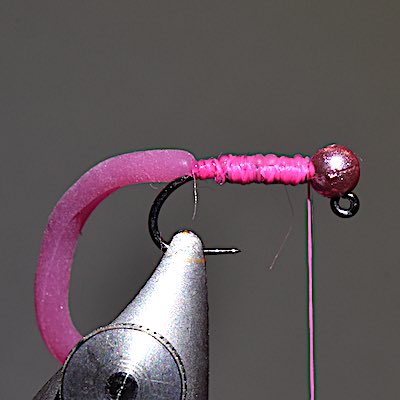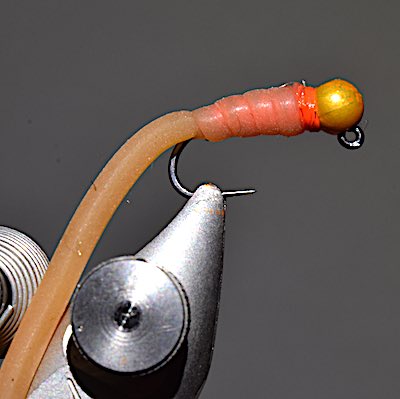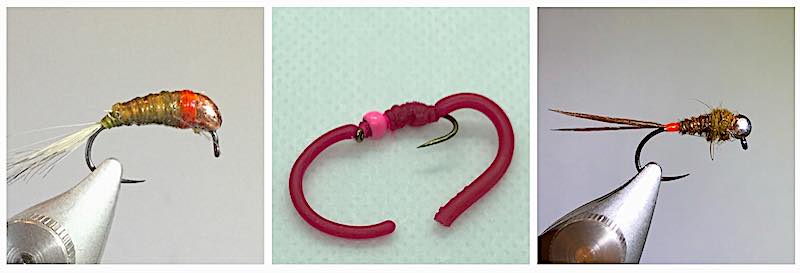The squirmy wormy is the ACE in my fly box, which I draw when fishing for trout and grayling becomes tough.
This card is usually played in poor weather and water conditions, and I’ve lost count of times these “flies” have…
Saved what was turning out to be a blank day.
Love or hate them, but they do catch grayling and trout when traditional fly patterns fail. Especially during the cold winter and spring months on rivers and stillwaters when…
Hungry fish are looking for a protein fix.
Often tying on a squirmy wormy fly pattern feels like cheating but that thought quickly disappears when I start catching trout or grayling.

How to tie Squirmy Wormy fly patterns
It’s possible to make these fly patterns as easy or complicated as you want but the main thing is to achieve a uniform and durable body.
Fly tying with the silicone body material takes some getting used to because of two issues.
- the wiggly silicone material is easily cut by the tying thread
- stopping it from moving around the hook shank.
With a little practice, the above issues can be overcome, and then the flies become easy to tie.
The variety of fly-tying materials on the market makes it possible to tie a seemingly, endless variation of fly patterns. However, I only use 3 – 4 variations most of the time.
So, what patterns do I tie and use…
First up is the hot pink pattern because it outperforms the others when fishing for winter grayling; especially, when the water is coloured.
Hot Pink Squirmy Wormy for grayling fishing
Tying material list:
- Hook: #12 or #14 HENDS BL 120
- Bead: 3 to 4mm slotted metallic pink tungsten
- Underbody: 8 turns of lead wire
- Thread: Fluorescent pink GLOBRITE floss
- Body & tail: Hot pink Veniard worm body
Step-by-step fly tying instructions:
Tips have been included in the tying procedure to help overcome the issues associated with using silicone material. These include…
- Use floss as the tying thread to avoid cutting the silicone material when it’s being secured
- adding lead wire to the hook shank to inhibit rotation of the silicone material when it’s being tied in.

Step 1. Thread a 3.5 mm metallic-pink slotted tungsten bead on the hook. Secure the hook in the vice and wind lead wire onto the shank of the hook.

Step 2. Tie in the pink floss at the hook bend and wind the thread up over the lead wire to the tungsten bead.

Step 3. Take a 50 mm length of silicone and tie it in by its tip with the thread. Next, carefully stretch the silicone and wind the thread to the hook bend. Don’t apply too much tension to the thread, otherwise it will cut through the soft silicone rubber.

Step 4. Wind the silicone around the hook in touching turns to form the worm body. Then, tie-off using two whip finishes. Don’t apply any glue to the thread because it will attack the silicone rubber. Finally, trim the tail to the desired length, my preference is around 30mm (just over an inch).
Normally I finish the flies at step 4, but you can tidy up the collar area with some coloured dubbing to improve its look.
The following video from Fly Fish Food explains the tying of a standard squirmy wormy in more detail…
Using silicone rubber and tungsten beads in different colours it is possible to tie many variations. The variations I use for trout and grayling fishing include…
Earthworm Squirmy Wormy

- Hook: #12 or #14 HENDS BL 120
- Bead: 3.5 mm metallic orange tungsten
- Underbody: 8 turns of lead wire
- Thread: Orange GLOBRITE floss
- Body & tail: Earthworm Veniard worm body
The Earthworm coloured body fly pattern is a good choice when fishing in clear water.
Blood-red Squirmy Wormy

- Hook: #12 or #14 HENDS BL 120
- Bead: 3.5 mm pink tungsten
- Underbody: 8 turns of lead wire
- Thread: Pink GLOBRITE floss
- Body & tail: Blood-red Veniard worm body
This fly has been tied with two tails but the single-tailed version is also effective. To tie the two-tailed version a tail is added at the bead end of the fly. Then proceed to step 3 (above) to tie in the second tail at the bend.
In addition to the above patterns, for Stillwaters it is worth tying a few fly patterns with more exotic colours, such as the Aqua Glow in the Dark.

Aqua Glow-in-the-Dark Wormy
- Hook: #12 or #14 HENDS BL 120
- Bead: 3.5 mm neutrak tungsten
- Underbody: 8 turns of lead wire
- Thread: Green GLOBRITE floss
- Body & tail: Aqua Glow in the dark worm body
When and how to fish Squirmy wormy
Originally they were developed for fishing rivers in the US for brown and rainbow trout. Since travelling across the Atlantic, the squirmy wormy has become deadly for catching fish on UK rivers and stillwaters.
Fishing on rivers
Usually, I only reach into my fly box for a Squirmy pattern when other flies have failed or when I think nothing else will work because of poor fishing conditions.
Through trial and error, I’ve found the best approach is to fish these flies on the middle dropper. This fished in combination with a heavier nymph on the point and a lighter nymph on the top dropper.
The following is an example of such a team for grayling and trout fishing I use on the Welsh Dee.
- point fly – #12 olive tungsten jig-back (gold)
- middle dropper – #14 hot pink squirmy wormy (3.5mm tungsten bead)
- top dropper – #14 pheasant tail nymph (3mm silver tungsten bead)

Short-range nymphing is the best approach to fishing these flies through likely runs and pools.
Typically, grayling take this fly quite lightly. Whereas, trout often smash it and almost pull the rod out of your hand.

A single-tailed version of the fly would have probably worked just as well.
Fishing on Stillwaters
Typically, on stillwaters the squirmy wormy is fished using two approaches…
a) Fished like a lure on an intermediate or sinking line. Cast it out, allow it to sink, and then pull it back using short erratic pulls to kick as much life into the legs as you can.
Often it is beneficial to pause several times during the retrieve because this provides time for slow-moving fish to take the fly.
While watching the fly, you’re likely to experience trout nipping at the fly before taking it. Therefore, it is best to do a short line strike when you feel a take and only lift the rod when you feel the fish is hooked.
If the fish hasn’t committed, the line strike keeps the fly close to the trout and helps maintain its interest.
Both single and double-tailed worms can be fished like a lure but the head-tail of the double-tailed fly can foul the hook.
b) Fishing it under the bung by casting it out and either leaving it to bob around on the drift or retrieving it using small twitches. These are good methods for catching trout lying close to the bank (e.g. near reed beds, under trees etc).

Finally, I hope this article stimulates you to tie some squirmy wormy flies and to test them on your local river or on a trip to fish the Welsh Dee at Llangollen.

As you say a really good “fly” to have in your arsenal
Thanks for the article
Best Wishes and Tight Lines in 2024
Hi Phil,
Great to hear you enjoyed the post.
Tight lines, Andrew
Great fly. I use a similar pattern called The Serial Killer. It has 2 small flexifloss loops. One either end of a glowbrite body. Cut a piece of squirmy material and push it through both loops. Fish it until it becomes too damaged, then replace the squirmy material.